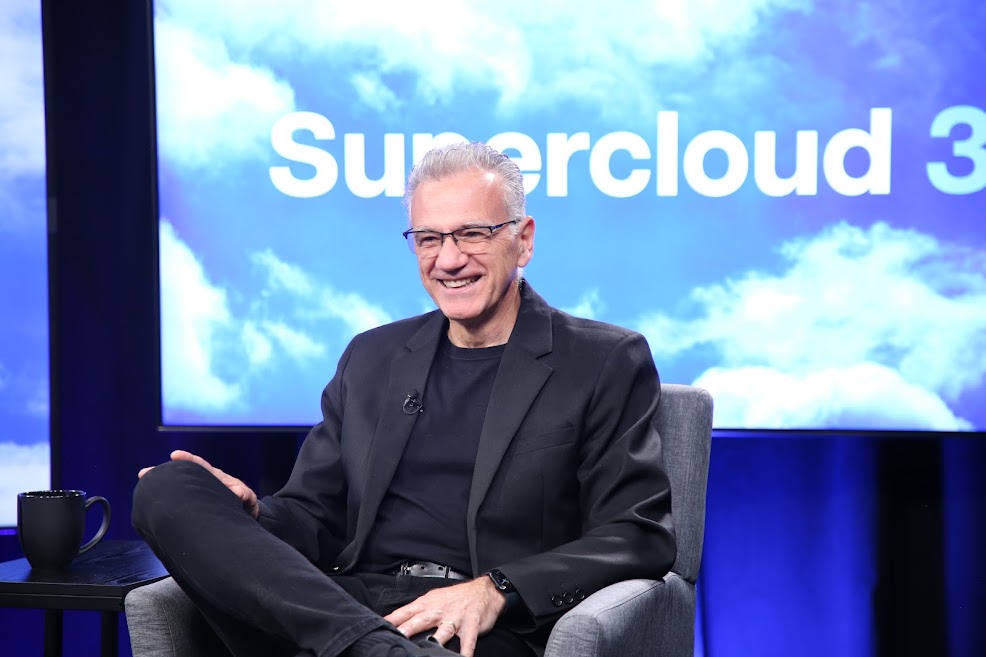 CLOUD
CLOUD
 CLOUD
CLOUD
 CLOUD
CLOUD
Over a lengthy career spanning high-level executive positions at Oracle Corp., MacAfee Corp., MobileIron Inc. and now VMware Inc., Vittorio Viarengo has observed the ebb and flow of technology trends.
VMware Inc.’s vice president of Cross-Cloud Services now finds himself in a position to see the approaching next wave of innovation, a viewpoint that is very familiar.
“I believe the supercloud is IT history repeating itself,” said Viarengo (pictured). “Products create sprawl, and sprawl gives you choice but then gives you cost and complexity. We believe that the supercloud is an industrywide movement.”
Viarengo spoke with theCUBE industry analysts Dave Vellante and John Furrier at the Supercloud 3: Security, AI and the Supercloud event, during an exclusive broadcast on theCUBE, SiliconANGLE Media’s livestreaming studio. They discussed how VMware developed its supercloud strategy, a resurgence of the private cloud and the growing influence of AI in driving multicloud decision-making.
Supercloud has been defined as an abstraction layer positioned above infrastructure to unite private, public, edge and other clouds using a consistent operating model. VMware has been assembling key pieces of its supercloud strategy for the past several years.
It acquired cloud-native platform provider Pivotal Software Inc. in 2019 and launched Cross-Cloud services in 2021. Aria, its multicloud management portfolio, was unveiled in summer 2022 and provided end-to-end solutions for managing the cost, performance, configuration and delivery of infrastructure and cloud-native applications.
“I would argue every company out there in Silicon Valley is a cross-cloud service company,” Viarengo said. “They will use whatever cloud makes sense for the need of their applications.”
One of the factors driving the need for cross-cloud services has been a noticeable interest among enterprises in shifting applications and workloads to the private cloud. The global pandemic, a more attractive cost structure and the rise of generative AI are the primary reasons behind a private cloud resurgence, according to Viarengo.
“Those three catalysts are making the private cloud more relevant today,” he said. “We always thought of the private cloud and datacenter as part of multicloud.”
In addition to driving renewed interest in the private cloud, generative AI is also being assessed for its potential capabilities to support supercloud operational needs. VMware views AI as an important piece of the cross-cloud services equation, and the company is planning to make announcements around AI at its upcoming Explore conference next month, according to Viarengo.
“We see a lot of buzz in the consumer space, but the huge value is going to be the enterprise,” he said. “AI is the ultimate cross-cloud [technology]. You’re going to hear more about our AI announcements and strategy at Explore.”
An operating role for AI in supercloud environments is being spurred by a lack of available talent in key technology fields. As multicloud usage continues to grow, an ability to manage more complex infrastructure will become a challenge. The solution may be dependent on creating an operational platform that can support the key work of developers, which has been a major focus for VMware.
“How are you going to find the talent and expertise across two, three, four clouds?” Viarengo asked. “We’re trying to understand what developers do and then give operations the tools. If they come on this journey with us, we are working to give them a pragmatic path to get there.”
Providing tools for developers and an attractive operational path are key elements in defining what supercloud will ultimately mean for customers. Cost savings and the power of the cloud are part of the core message, as is an ability to offer a friction-free experience.
“It’s an opportunity to unleash the power of every cloud at a sustainable cost, and it represents a career path,” Viarengo said. “One of the main advantages of the supercloud, for people who do it right, is it removes friction from the system. Enable the developers to do what they do. Plug into their workflow without introducing friction.”
At the outset of the interview with Viarengo, theCUBE’s analysts noted that he had been one of the first to spot the growth of supercloud platforms and identify what this could mean for information technology and the enterprise. Proponents of supercloud as a trend worth watching have endured their share of skepticism from others in the industry.
Viarengo listened closely to what he was hearing from technologists and made the point that technology evolution is a story of change often missed by many in the thick of it. History repeats itself again, he explained.
“For the skeptics out there, when you are in the middle of transformation, the majority of people don’t see it,” Viarengo said. “You have to bring this level of abstraction or you cannot unleash this next level of growth.”
Here’s the complete video interview, part of SiliconANGLE’s and theCUBE’s coverage of the Supercloud 3: Security, AI and the Supercloud event:
THANK YOU